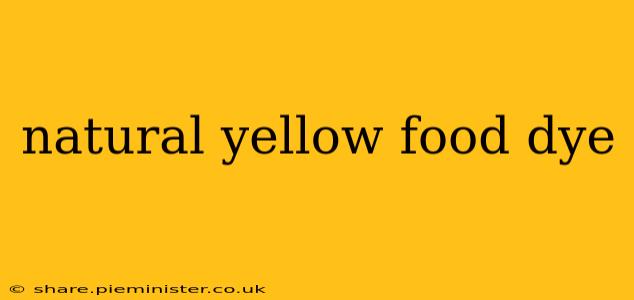Achieving vibrant yellow hues in food without resorting to artificial dyes is easier than you might think. Many natural ingredients offer beautiful, safe, and delicious ways to add a sunny splash of color to your culinary creations. This comprehensive guide explores the world of natural yellow food dyes, examining their sources, applications, and benefits.
What are the Best Natural Yellow Food Colorings?
Several natural ingredients provide a beautiful yellow color to food. The intensity and shade of yellow can vary depending on the source and concentration. Popular choices include:
-
Turmeric: This powerful spice offers a deep golden-yellow color, along with a distinct earthy flavor and numerous health benefits. It's excellent for curries, rice dishes, and even baked goods.
-
Saffron: While expensive, saffron delivers a vibrant, almost orange-yellow hue. A small amount goes a long way. Its distinct flavor is best suited for dishes where its unique taste complements the other ingredients. Think paella or delicate custards.
-
Annatto: Derived from the seeds of the achiote tree, annatto produces a reddish-orange to yellow color, depending on concentration. It's frequently used in cheeses, butter, and rice dishes.
-
Carrot Juice: A simple and readily available option, carrot juice provides a soft, light yellow color. It's best for applications where a subtle yellow tint is desired, such as smoothies or sauces.
-
Yellow Bell Peppers: Pureeing yellow bell peppers yields a vibrant yellow color, although it may require a significant amount for intense coloring. This option works well in dips, sauces, and soups.
What are Some Common Uses for Natural Yellow Food Coloring?
The versatility of natural yellow food dyes is remarkable. Their applications span a wide range of culinary creations:
-
Baking: Turmeric and carrot juice can subtly tint cakes, cookies, and breads, adding a warm, golden hue.
-
Cooking: Many savory dishes benefit from natural yellow dyes. Turmeric is essential in curries, while annatto enhances the color of rice and cheeses.
-
Beverages: Carrot juice is a perfect addition to smoothies, adding a subtle yellow color and a boost of nutrients.
-
Confections: Saffron can add a luxurious touch to candies and frostings.
-
Desserts: Yellow bell peppers can create a vibrant yellow filling for pastries or brighten up creamy desserts.
How Do I Use Natural Yellow Food Coloring?
The method of using natural yellow food dye varies based on the ingredient. Generally, it involves extracting the color through methods like blending, juicing, or infusing. Remember that the intensity of color depends on the concentration of the ingredient. Experimentation is key to achieving your desired shade.
Is Natural Yellow Food Coloring Safe?
Generally, natural yellow food coloring is considered safe for consumption. However, individual sensitivities and allergies should always be considered. Always source your ingredients from reputable suppliers.
What are the Benefits of Using Natural Yellow Food Dye Compared to Artificial Dyes?
Natural yellow food coloring offers several advantages over artificial counterparts:
-
Healthier Option: Many natural options provide additional nutritional benefits like antioxidants or vitamins.
-
Better Flavor: Natural dyes often add subtle flavor notes that enhance the overall taste profile of the food.
-
Environmentally Friendly: The production of natural dyes generally has a lower environmental impact compared to artificial dyes.
-
More Appealing to Consumers: Many consumers are increasingly seeking out products made with natural ingredients.
What are the Differences Between Different Types of Natural Yellow Food Colorings?
The key differences lie in the intensity of color, the flavor profile imparted, and the potential health benefits. Turmeric offers a deep golden yellow and a distinct earthy flavor, while saffron delivers a more vibrant, slightly orange-yellow tint with a unique and delicate flavor. Carrot juice, on the other hand, offers a soft, subtle yellow color with a mild taste. Each option caters to different culinary applications and preferences.
How Can I Make My Own Natural Yellow Food Coloring?
Creating your own natural yellow food coloring is straightforward. For instance, simply blend carrots with a little water, strain the mixture, and you have a vibrant yellow liquid. For turmeric, you can steep it in hot water to release its color, or simply grind it into a powder for direct use. Remember to adjust the concentration to achieve your desired shade.
This guide offers a comprehensive overview of natural yellow food dyes, their uses, and their benefits. By embracing these natural alternatives, you can create beautiful, healthy, and delicious food that appeals to both your eyes and your palate.
